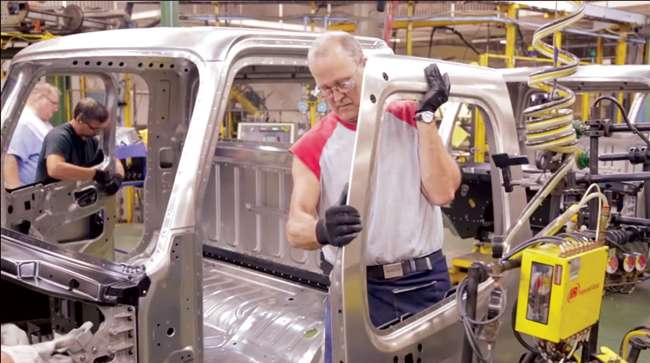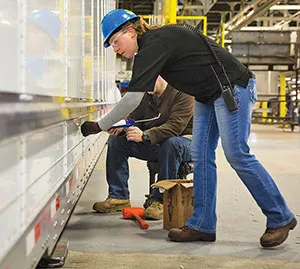Senior Reporter
Equipment Trends in 2022 Find Room for Surprises

[Stay on top of transportation news: Get TTNews in your inbox.]
For the first 10 months in 2022, the supply chain still posed difficulties for manufacturers of new trucks and trailers. In many cases, there were not enough workers. Orders were restricted. The backlog got lengthy.
Manufacturers worked to build and sell as much equipment as they could under the difficult conditions. (Transport Topics was awaiting the year’s final data as this story went to press.)
The limited production could not satisfy customers’ demand to replace aging trucks they were forced to run longer, or the need for additional trailers to meet strong freight demand.
Each month, data from truck sales, truck orders, trailer orders and used Class 8 sales served as the pulse of the industry.
In some cases, monthly totals were better in comparison with 2021, some spectacularly so.
Preliminary NA #Class8 net orders in November were 33,000 units, while NA #Classes5-7 net orders were 21,400 units. Complete industry data for November, including final order numbers, will be published by #ACTResearch in mid-December.https://t.co/fHj314alWq pic.twitter.com/8fq7MaLnEm — ACT Research (@actresearch) December 7, 2022
Class 8 U.S. retail sales began slowly then settled in at around 20,000, largely improving on year-earlier monthly totals, according to Wards Intelligence.
“Stasis is the word that comes to mind,” ACT Research Vice President Steve Tam told Transport Topics at the time. He said there was a little uptick in the build rates truck makers reported in October but nothing to lead him to think breakout numbers for retail sales are coming anytime soon.
Medium-duty U.S. retail sales in Classes 4-7 dropped in nine of the first 10 months compared with monthly totals in 2021, according to Wards. In a weakened supply chain, some manufacturers cobbled together common parts to put on more profitable heavy-duty trucks.
Meanwhile, Class 8 North American orders through August chugged along, staying below year-earlier levels and below 22,000, sometimes far below. That is until September when they skyrocketed to 53,271 — the all-time high.
Why? Truck makers opened the dealer order boards for 2023, reflecting improved visibility on the availability and prices of materials.
“It is possible, too, that the truck makers can’t hold back any longer and their customers are demanding the trucks. Prices can be negotiated depending on circumstances,” said Tam then.

Workers apply touches to a trailer at a Stoughton manufacturing plant. (Stoughton Trailers)
Also in October, trailer manufacturers finally opened production slots for 2023. Orders surged to 47,860. It was the most in two years.
Orders until that point in 2022 had waxed and waned, often to below 20,000.
“I think there’s still plenty of pent-up demand in the trailer industry,” said David Giesen, vice president of sales at Stoughton Trailers. “We’re all cautiously plugging into our backlog.”
Class 8 used truck U.S. retail sales held few surprises through October, keeping in the 20,000 range, but prices sure did drop some jaws.
The average retail price in March of a used Class 8 vehicle pushed past the $100,000 mark for the first time, ACT reported. It was $101,716. A year earlier it had been $53,412. Not quite double, but darn near. The previous record was set a month earlier in February at $94,321.
Then in April the average price fell month-over-month for just the second time since July 2020.
Later, in a directional move that caught the attention of many, the average U.S. retail price in October for a used Class 8 fell 1.5% compared with September’s, a sequential drop that led some to wonder whether month-over-month prices were finally depreciating normally.
October’s average retail price was $83,228 compared with $72,212 a year earlier and September’s $84,515, according to ACT.
Tam suggested what was occurring was simply a little closer alignment of supply and demand, “but we expect demand to continue to deteriorate at the same time supply is increasing.”
Through 10 months, ACT estimated used Class 8 retail sales slipped to 203,800, down 7.5% compared with 220,500 in the 2021 period.
Daimler Truck North America — the market leader in Class 8 U.S. retail sales — announced in April the launch of a broad company initiative to fight what it termed the pervasive theft of common powertrain controller (CPC4) modules from its vehicles — including used trucks awaiting resale.
Others, with criminal intent, put new and used trucks under their surveillance, then moved in.
Want more news? Listen to today's daily briefing above or go here for more info
Trucks cannot operate without a CPC to control various engine and powertrain functions, and experts said they should be password-protected.
Reported thefts of CPC4 modules from parked trucks have been on the rise, DTNA found, with thieves seeking reprogramming and re-installation on other trucks. In one theft in April, modules were reported stolen from 24 used trucks waiting to be sold at an auction yard in Pennsylvania. A large number of other thefts have occurred at dealerships and customer terminals.
“This is not surprising, given the serious shortage of parts, ECUs, and other computer chip-related components,” Technology & Maintenance Council Executive Director Robert Braswell told Transport Topics in April.
TMC is a division of American Trucking Associations.




